鱼眼镜头
鱼眼镜头指視角接近或等於180°的鏡頭,視角為眾多鏡頭之冠。這類鏡頭一般焦距極短,在135底片格式下,16毫米或焦距更短的鏡頭通常即可認為是魚眼鏡頭,絕大部分的魚眼鏡頭均是定焦鏡頭,只有少部分是變焦鏡頭。依成像可分為圓形魚眼(,又稱全周魚眼,畫面呈圓形)與對角線魚眼(或,畫面呈方形)其鏡面似魚眼向外凸出,所視的景物,像魚由水中看水面的效果。鱼眼镜头一般用來拍攝廣闊的風景或於室內拍攝。不少攝影師喜歡使用魚眼鏡的誇張變形來營造透視感。歷史上,135画幅最廣的魚眼鏡頭是尼康旗下的6毫米f/2.8,視角接近220°。而富士能研发了世界首台用于五百万像素CCD摄像机的185°广角全方位镜头。
.jpg.webp)
圓形鱼眼镜头的效果

對角線鱼眼镜头的效果
应用
鱼眼镜头以起源来说,出于在地面观测穹顶天象变化而设计,盖因为其可以在一张照片内尽可能收录尽可能广的视角,这是广角镜头乃至超广角镜头都做不到的。摄影中也以这一特性来在狭小的场景中记录尽可能多的信息。
与之相对的,鱼眼镜头没有将场景校正为横平竖直的设计,会有较多变形。在摄影应用中,也利用该特性来进行夸张表现。
在安防监控领域,鱼眼镜头也用于狭小空间中。随着运动相机的兴起,如GoPro等也选择为相机配置一枚固定不可更换的鱼眼镜头,力求收录尽量大的视场。
全景摄影中也会选择鱼眼镜头进行拍摄,以提升效率。例如一次成像的全景相机理光THETA,即在机身相对位置布置了两枚鱼眼镜头以采集全天球图像。
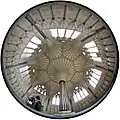 韦尔斯座堂内景
韦尔斯座堂内景 欧洲南方天文台(ESO)内庭
欧洲南方天文台(ESO)内庭 协和广场
协和广场
常見的魚眼鏡頭
单反用镜头

尼康6mm F2.8鱼眼镜头,1972年产。
单反相机上常见的鱼眼镜头有如下项目:
- Canon FD 7.5mm f/5.6
- Canon EF 15mm f/2.8
- Canon EF 8-15mm f/4 USM -S
- Nikkor 8mm f/2.8
- Nikkor 6mm f/2.8
- Nikkor DX AF 10.5mm f/2.8G ED
- Nikkor AF 16mm f/2.8D
- Nikkor AF-S 8-15mm f/3.5-4.5E ED
- Minolta/Sony AF 16mm f/2.8 Fisheye
- Olympus Zuiko Digital ED 8mm f/3.5
- Pentax DA 10-17mm f/3.5-4.5 ED (IF)
- Peleng 8mm f/3.5
- Samyang 8mm f/3.5
- Sigma 4.5mm f/2.8 EX DC
- Sigma 8mm f/3.5 EX DG
- Sigma 15mm f/2.8 EX DG
- Sigma 10mm f/2.8 EX DC
- Sunex 5.6mm f/5.6
- Tokina 10-17mm f/3.5-4.5
- Vemar 12mm f/5.6
- Zenitar MC 16mm f/2.8
无反用镜头
而随着无反相机的兴起,也有厂家推出用于适配的鱼眼镜头:
- 奥林巴斯 8mm F1.8 Fisheye Pro[1]
- 松下 Lumix G 8mm F3.5[2]
- 奥林巴斯 BCL-0980
- 三阳 7.5mm F3.5
- 安原制作所 MADOKA
- 三阳 8mm F2.8
除此之外,在既有镜头上添加专门设计的鱼眼附加镜也是常见的一种选择。例如索尼的E16镜头配合ECF-1附加镜,可以实现鱼眼镜头效果。
映射方式
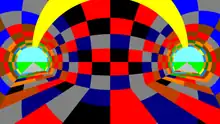 Stereographic
Stereographic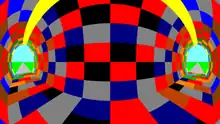 Equidistant
Equidistant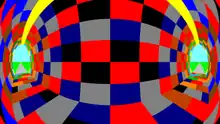 Equisolid angle
Equisolid angle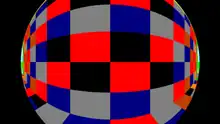 Orthographic
Orthographic
应用在鱼眼镜头上的映射方式有四种:
- Stereographic (conform):. Maintains angles. This mapping would be ideal for photographers because it doesn't compress marginal objects as much. Samyang is the only manufacturer to produce this kind of fisheye lens, but it is available under different brand names. This mapping is easily implemented by software.
- Equidistant (linear scaled):. Maintains angular distances. Practical for angle measurement (e.g., star maps). PanoTools uses this type of mapping.
- Equisolid angle (equal area):. Maintains surface relations. Every pixel subtends an equal solid angle, or an equal area on the unit sphere. Looks like a mirror image on a ball, best special effect (unsophisticated distances), suitable for area comparison (clouds grade determination). This type is popular but it compresses marginal objects. The prices of these lenses are high, but not extreme.
- Orthographic:. Maintains planar illuminance. Looks like an orb with the surroundings lying on < max. 180° aperture angle.
参考与引用
- The world's first f/1.8 fisheye lens (页面存档备份,存于) - Olympus(英文)
- H-F008GK 鱼眼定焦镜头 (页面存档备份,存于) - 松下(中国)
外部链接
- 镜头产品介绍 (页面存档备份,存于) 微型4/3系统
- 鱼眼、超广镜头,超视角全景摄影 (页面存档备份,存于) - 色影无忌
This article is issued from Wikipedia. The text is licensed under Creative Commons - Attribution - Sharealike. Additional terms may apply for the media files.